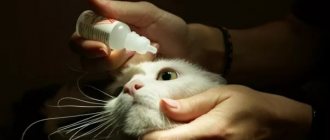In cats, spotting can be either normal or a sign of serious illness. In the first case, they accompany normal physiological processes, such as estrus or cleansing of the uterine cavity after childbirth. But if the discharge appears at the wrong time, causes discomfort to your pet and has a foul odor, you should consult a veterinarian as soon as possible. If this is not done, the animal may die.
So, how to distinguish normal discharge from pathological ones and how to treat a cat?
Reasons for appearance
Normally, bloody discharge appears in a cat for the following reasons:
- Estrus. The discharge indicates that the cat is ready to mate and bear offspring; its duration is several days. At the same time, the secretion does not have an unpleasant odor, and when the animal licks itself, it does not leave marks on surrounding objects. It is important to remember that spotting during estrus is typical for untied cats. After the first birth they will always be transparent.
- During pregnancy. Normally, during the entire period when a cat is bearing offspring, she should not be bothered by discharge. Ichor may be released during contractions.
- After the birth of kittens. The animal’s body is recovering, so during the first three weeks after birth, the presence of spotting is considered normal. In this case, the pet should feel well, eat as usual and carefully care for the offspring. If the discharge continues for more than the specified period, and the cat becomes lethargic, then it needs to be shown to a veterinarian.
A small amount of blood from the uterus can be released in cats only for the reasons described above. If the secretion is copious, foul-smelling, or includes particles, then this may be a symptom of many diseases of the genitourinary system or a sign of uterine bleeding.
Features of the first heat
Established conditions for breeding purebred cats prescribe breeding mature animals no earlier than the first year of life. It is believed that during this period the formation is completed and there is a physiological opportunity for the birth of offspring.
For the first time this process usually begins at the age of 10-11 months, it is then that a female can be brought together with a male.
In fact, it all depends on the breed, temperament, health status and other individual characteristics. In some pets, the first discharge appears at 7-8 months, but knitting at this age is not recommended, the body is not yet ready for childbearing.
Often there is a problem of early estrus in a purebred cat, on which the breeders had great hopes. In this case, doctors advise removing the pet from breeding, since the problem can be inherited. In this case, veterinarians insist that the cat be sterilized.
However, if the owners of the animal are categorically against it, it is necessary to begin treatment with medications as early as possible in order to improve the hormonal balance and the functioning of all body systems.
Dangerous diseases
Cats may experience atypical bloody discharge, which is a symptom of the following diseases:
- endometritis and pyometra are infectious diseases in which the uterine mucosa becomes inflamed and begins to bleed;
- inflammatory processes in the genital organs - their causes are varied, ranging from stress to infection, often ending in cystitis;
- phlegmon - under the influence of unfavorable factors, the cat experiences swelling of the genitals and the formation of ulcers;
- vaginitis - inflammation of the vagina caused by infections or injuries after unsuccessful medical procedures;
- tumor process in the uterus - as a rule, it is malignant in nature, the animal experiences destruction of soft tissues;
- placenta in the uterus - if not all placenta came out during childbirth, this leads to an inflammatory process in the uterus;
- various injuries to the genital organs - most often the cause is a poorly performed operation, which leads to bleeding.
The diseases described above have many similar symptoms:
- the animal becomes lethargic and drowsy;
- the cat tries to hide from its owners and other pets and shows no interest in playing;
- food refusal is observed, the animal may not drink well;
- a secretion is released from the genital organs, which, depending on the pathology, can be foul-smelling, with traces of pus and particles of mucous membrane;
- blood loss continues for a long time without a tendency to stop;
- The animal's temperature rises and does not subside.
To find out what exactly your pet is sick with, you need to contact a veterinarian as soon as possible. Independent attempts to find out what exactly is happening with the cat will not only not lead to success, but will also lead to the loss of precious time.
Risks of the condition
Regular or large amounts of blood loss can weaken even the strongest organism, which cannot cope with bleeding on its own without outside intervention. Severe blood loss in a cat can result in the following:
A single bleed in a cat is not dangerous.
- disruption of mechanical circulatory function;
- insufficient filling of blood vessels and cardiac compartments with blood;
- falling blood pressure;
- a sharp decrease in red blood cells and a drop in hemoglobin levels leads to the development of anemia;
- tissue hypoxia (oxygen starvation) due to a disrupted process of oxygen transfer through vessels to tissues and organs;
- disruption of local metabolic processes, which leads to massive cell death, and then the death of the organism.
Treatment
Before starting to treat the animal, the doctor finds out the root cause of the discharge. This will require the following examinations:
- initial examination of the animal, careful palpation of the abdominal area;
- general and biochemical blood test, laboratory urine test;
- Ultrasound of internal organs;
- examination of the uterus using a colposcope;
- study of secretions;
- bacterial culture to identify the pathogen;
- biopsy of the mucous membranes of the genital organs.
Based on the research results, the doctor makes a diagnosis and prescribes the necessary medications and procedures.
Depending on the reason for the bleeding, the cat is prescribed the following treatment:
- Anti-shock therapy is carried out using painkillers.
- If your cat is bleeding heavily, a blood transfusion may be required.
- If the bleeding is caused by low blood clotting, then corrective therapy is prescribed.
- For pathologies such as tumors or endometritis, surgery followed by chemotherapy is indicated to reduce the risk of relapse.
- The animal is prescribed antibiotics when the disease is caused by pathogenic microorganisms.
All medications and their dosage can be prescribed and adjusted only by a veterinarian. Self-medication will not only not bring a positive result, but can also lead to the premature death of your pet.
What to do if your cat is bleeding
A pet with bleeding requires an urgent professional examination, which will establish the correct diagnosis and prescribe the necessary treatment. Attempts to stop prolonged or heavy blood loss using folk remedies can lead to the death of the cat. This is especially true in cases of bleeding in a kitten, since there is little blood in its body, and the loss of even the smallest dose can provoke the death of the baby.
Did your cat fall out of a window, get hit by a car, or become a victim of a beating? It is highly recommended that you visit a veterinarian, even if there are no visible injuries and your pet appears normal. Internal bleeding that does not open immediately after an injury can appear at any time due to a burst hematoma or a purulent process. It is recommended to carefully move the injured animal into a box with a hard bottom in order to eliminate complications from a possible spinal fracture.
Professional veterinary care
A cold compress is applied to the suspected bleeding site. If possible, the mouth and airways are carefully cleared of blood or vomit. It is strictly forbidden to feed or water an injured cat. If your pet loses consciousness, it is not recommended to stir, trying to bring him back to his senses, as such actions can aggravate the condition.
Note! If a cat is bleeding profusely from the uterus, you can give it water or warm broth and urgently visit a veterinarian or call him at home.
Care, maintenance and treatment of your pet
In order for treatment measures to bring positive results more quickly, owners need to provide the cat with proper care:
- Provide a secluded place for the animal, put a disposable sheet on the bed and change it regularly when it gets dirty.
- The room where the sick cat is located must be warm and free of drafts, and it must be ventilated regularly.
- During treatment, it is forbidden to let your pet go outside; its communication with other pets should be limited.
- The cat must have constant access to drinking water. If the animal refuses to drink or is too weak, you need to give it water yourself using a syringe, after removing the needle.
- During the illness, the animal should receive nutritious and easily digestible food. These can be meat broths, to which chopped meat, fermented milk products, cereals and vegetables are added in small quantities. On the advice of a veterinarian, you can purchase special medicated food so that the animal gains strength faster.
To protect your pet from diseases that lead to bleeding, you must adhere to the following preventive measures:
- If the cat is not intended for breeding, it makes sense to sterilize the pet. This will protect her from many diseases that occur in the genitourinary system. After the procedure, the cat should be regularly shown to the veterinarian for an ultrasound, this will help to better monitor the animal’s health.
- Get all necessary vaccinations and antihelminthic treatment in a timely manner to maintain the body's defenses.
- For mating, choose a healthy male cat; the owners of the male must document this.
- When giving birth to a cat, use sterile consumables and thoroughly treat your hands with antiseptics.
- If any unusual discharge occurs, you should take your cat to the veterinarian as soon as possible.
The measures described above will help not only prevent the development of the disease, but also, if necessary, show the cat to a specialist as soon as possible without wasting time.
Bloody discharge accompanied by a significant deterioration in the animal’s condition is a formidable sign indicating the development of severe pathology. There is no need to try to find the cause on your own, but take the cat to the veterinary clinic as soon as possible for examination and treatment.
Stages of heat
Physical maturity occurs at approximately six months. As soon as this period begins, the pet can already produce offspring by becoming pregnant. It continues until the animal is old - about 8-9 years. Estrus occurs in four phases:
Proestrus
Duration is 1-4 days. This is the preparatory stage. Restlessness is the main characteristic of this time. The cat won't let the cat near her and is a little aggressive and doesn't eat well.
Estrus
Duration on average is 7-12 days. The pet's behavior changes, sex hormones raging in the body force it to quickly identify the male and carry out planned or spontaneous mating with him.
Metestrus
The final stage lasts about a week. This is a period characterized by pregnancy or non-occurrence and relative rest. Sometimes false gestation of kittens can develop if conception does not occur during estrus. A cat can react aggressively to a cat, even one that has undergone castration.
Anestrus
This is a time of peace. In healthy cats, this period takes about three months and usually occurs during the winter and summer months. At this moment, the animal is calm and leads its usual lifestyle.
Maximum sexual activity is observed in early spring, usually February-March. If during this time the desired pregnancy does not occur, estrus occurs every couple of weeks.
What to pay attention to
Representatives of the cat family are very clean, so the owners of the animal may not immediately notice pathological discharge from the genitals. Indirect signs should alert you.
The first thing that arouses suspicion is that the cat often licks the perineum (every 15-20 minutes). Frequent urination is the second warning sign. Itching manifests itself as follows: the animal rubs its perineum on the floor or some objects. All indirect signs should force the owner to pay close attention to the pet.
Clinical picture and symptoms
Sometimes in cats you can observe pink discharge from the genital slit. They can look completely different:
- Transparent pinkish discharge in small quantities.
- Bright pink thick discharge.
- Purulent pink discharge.
- Pink liquid with an unpleasant odor.
The intensity of the discharge also varies. This may be an isolated case, or the fluid is leaking constantly.
This condition can be completely asymptomatic or accompanied by severe symptoms. The most common symptoms are pain, fever, itching in the genital area, and lethargy.
Blood in urine: what is dangerous for an animal
The appearance of red blood cells in the urine indicates tissue destruction, including the walls of blood vessels. The gates of infection open, opportunistic microflora gain access to the underlying tissues and feed on them.
Affected organs lose their functions. The animal dies or requires lifelong treatment. Diseases occur differently in different animal species.
Blood in urine in cats
Males have long and tortuous urinary tracts. Therefore, the precipitated grain of uric salt sand is not washed out by a stream of urine, but gets stuck. An obstacle is formed, urine stagnates, bacteria are retained, attached to the walls of the bladder, multiply, and their pathogenic ability increases. Microbes enter the kidneys and their destructive work begins.
Be sure to read:
Vomiting in a cat: causes, what different types of vomit indicate, first aid, treatment, when it is not dangerous
Blood enters the urine in two ways:
- as a result of mechanical trauma when a stone with sharp edges passes through the ureter;
- exit from blood vessels during tissue breakdown.
Blood in urine in cats
In addition to physiologically justified bleeding, females develop pathological hematuria. The excretory canal in cats is straight and short, so urolithiasis occurs in them 6 times less often than in cats. The greatest danger is caused by the release of blood from decaying tumor tissues.
Older animals are most often affected. Cat owners are not always happy about the appearance of kittens and use contraceptives such as Stop-intim or Antisex. Side effects of such drugs include benign or malignant tumors of the genitourinary system.
Blood in the urine of sterilized animals
Pets with the gonads removed suffer almost no illness, except for urolithiasis or cystitis. Metabolism changes, motivation to move disappears.
Animals need special, expensive ready-made feed. The use of natural products or ready-made economy-class feed guarantees the occurrence of the disease. Obesity slows down your metabolism. Urine stagnates, conditionally pathogenic microbes that constantly live in the cat’s body multiply.
The second factor is the relatively narrow lumen of the urethra. Cats are sterilized at 8-10 months, when growth is not yet complete. Animals continue to gain weight, but the size of the urinary ducts remains the same.
Diagnostics
Cat diseases are successfully diagnosed in modern veterinary clinics, where there is all the necessary equipment for this. To make an accurate diagnosis, your doctor may prescribe the following tests:
- Inspection and palpation.
- Ultrasound examination of the uterus, ovaries, kidneys, bladder. If the problem lies in diseases of these organs, then such a study is sufficient.
- Blood and urine tests. These studies will help determine the presence of an inflammatory process in the cat’s body. A urine test may suggest an attack of urolithiasis.
- Vaginal smear (to determine microflora and possible infections).
- X-ray examination. This method allows you to detect tumors and metastases in cancer.
- Tissue biopsy for suspected cancer.
Cat diseases have been well studied, so diagnosis is not difficult for specialists.











